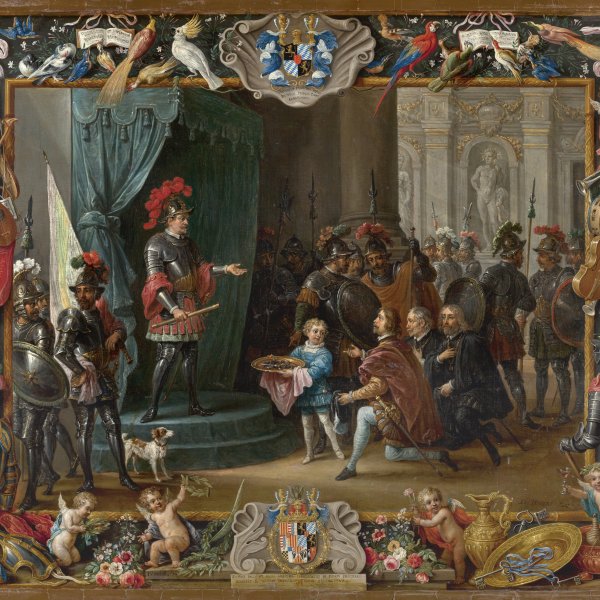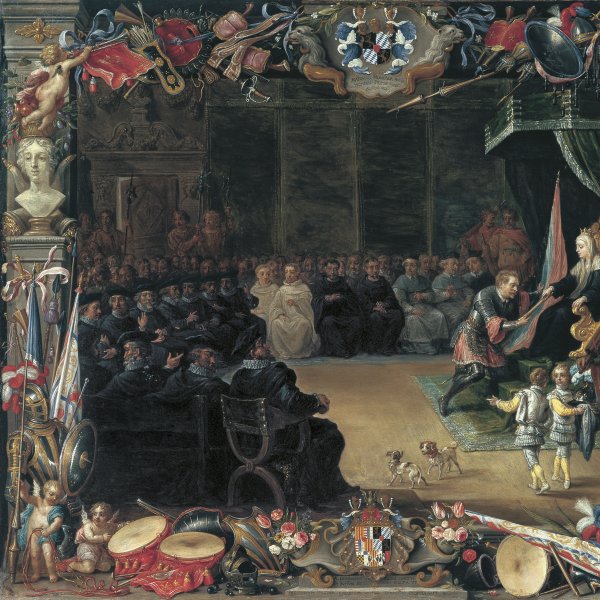David Teniers II and Jan van Kessel I
Antwerp, 1610-Brussels, 1690 and Antwerp, 1626-79
Jan van Kessel I was born in Antwerp in 1626. Related to the Brueghel family, he was the son of the portrait painter Hieronymous van Kessel II, grandson of Jan Brueghel the Elder and nephew of David Teniers II. Van Kessel trained in the studio of Cornelis de Vos, although he may also have received classes from his uncle, Jan Brueghel the Younger. In 1645 he is recorded in the guild of Saint Luke in Antwerp as a blomschilder [flower painter]. In 1647 he married Maria van Apshoven. Jan van Kessel had seven children, of whom two trained with him to become painters: Ferdinand, who continued his father’s style, and Jan van Kessel II, who focused on portraiture, like his grandfather.
Jan van Kessel I left behind a large and varied oeuvre that includes flower paintings, still lifes, animals, landscapes, allegories and religious paintings. He principally worked in a small format on wood or copper panels. His floral still lifes, with their porcelain or glass vases, continue the type developed by Brueghel but his flower garlands are clearly inspired by the work of Daniel Seghers, for example Garland with the Temptations of Saint Anthony (Brussels, Musées Royaux des Beaux-Arts). For works of this type Van Kessel frequently collaborated with David Teniers II, who executed the small scenes set within the garlands. During his mature phase Van Kessel painted the decorative borders for a series of twenty paintings that illustrate the lives of Antonio and Ramón Moncada, two Sicilian nobles of Spanish origin. The central images in these panels were painted by David Teniers II, Willem van Herp, Adam Frans van der Meulen, and Luigi Primo. The decorative surrounds differ from the type developed by Seghers and are organised in the manner of a broad frame with a wealth of allegorical elements that relate to the central scene. Van Kessel was also important as an animal painter, focusing his attention on insects and small creatures, which until that point had only played a decorative role in floral still lifes and garlands. From the mid-1650s he produced an original series of small paintings, executed in minute detail and with great realism, of centipedes, butterflies, beetles and other insects.
Jan van Kessel I left behind a large and varied oeuvre that includes flower paintings, still lifes, animals, landscapes, allegories and religious paintings. He principally worked in a small format on wood or copper panels. His floral still lifes, with their porcelain or glass vases, continue the type developed by Brueghel but his flower garlands are clearly inspired by the work of Daniel Seghers, for example Garland with the Temptations of Saint Anthony (Brussels, Musées Royaux des Beaux-Arts). For works of this type Van Kessel frequently collaborated with David Teniers II, who executed the small scenes set within the garlands. During his mature phase Van Kessel painted the decorative borders for a series of twenty paintings that illustrate the lives of Antonio and Ramón Moncada, two Sicilian nobles of Spanish origin. The central images in these panels were painted by David Teniers II, Willem van Herp, Adam Frans van der Meulen, and Luigi Primo. The decorative surrounds differ from the type developed by Seghers and are organised in the manner of a broad frame with a wealth of allegorical elements that relate to the central scene. Van Kessel was also important as an animal painter, focusing his attention on insects and small creatures, which until that point had only played a decorative role in floral still lifes and garlands. From the mid-1650s he produced an original series of small paintings, executed in minute detail and with great realism, of centipedes, butterflies, beetles and other insects.






